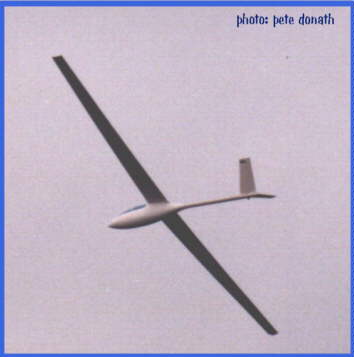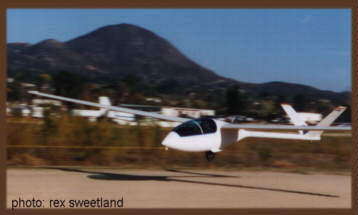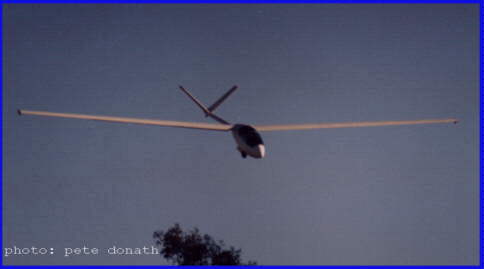
By Kevin Perry

Structure: metal, fiberglass, and foam
Airfoil: Wortmann FX 67-150
Design: Pod & boom fuselage, V-tail
Metric English
Wingspan: 15 m 49.2 ft
Wing area: 10.48 m^2 113 sq. ft
Aspect ratio: 21.4 21.4
Empty weight: 238 kg (typical) 525 lbs (typical)
Water ballast: 91 kg 200 lbs
Gross weight: 409 kg 970 lbs
VNE: 243 km/hr 150 mph (130 knots)
Max L/D: 38:1 38:1
The only Schreder sailplane to bear the designer's initials in the designation (instead of the usual "HP"), the RS-15 is a kit built sailplane designed by Richard Schreder of Bryan, Ohio. It was designed as a no compromise racer for the then new FAI 15 meter class in the early 1970's.

It combines Schreder trademarks of 90 degree landing flaps in lieu of spoilers, a 'V' tail with fixed stabilators and mass balanced ruddervators, retractable gear, interlocked flaps and ailerons and a steerable tail wheel. Forward fuselage is fiberglass, the balance of the craft is aluminum skinned with the wing skins bonded to closely spaced foam ribs over an aluminum wing spar consisting of two hefty tapered c-channels separated by two shear webs. The interior of the wing spar is sealed and forms the water ballast tank. Unlike other metal skinned sailplanes, the 4" rib spacing and bonded construction result in a wing that is totally quiet even in the roughest air and retains its contour and finish for hundreds of flight hours.
In flight, it rewards it's pilot with plenty of performance, well finished examples show performance similar to PIK-20's and LS-3's. Handling characteristics are straightforward, but the ship reflects it's contest heritage with low stability on all three axes and delivers best performance and handling near aft CG.

Towing is via retractable nose hook which accepts a Schweizer style ring. Flaps are generally positioned to -10 degrees for take off roll, +10 for take off, normal tow and thermaling, 0 to -10 for cruise and 20 to 90 degrees for pattern and landing, with -10 recommended again for the final landing rollout for best aileron control.
Landings feature the incredible braking action of 16.5 square feet of flap. Glide ratio sinks to a minimum of about 2:1 and the pilot finds himself standing on the rudder pedals with 45 degrees nose down to hold 50 mph.

Experienced HP pilots have been seen to touch down and roll out in less than 100 feet with a ten knot headwind component.